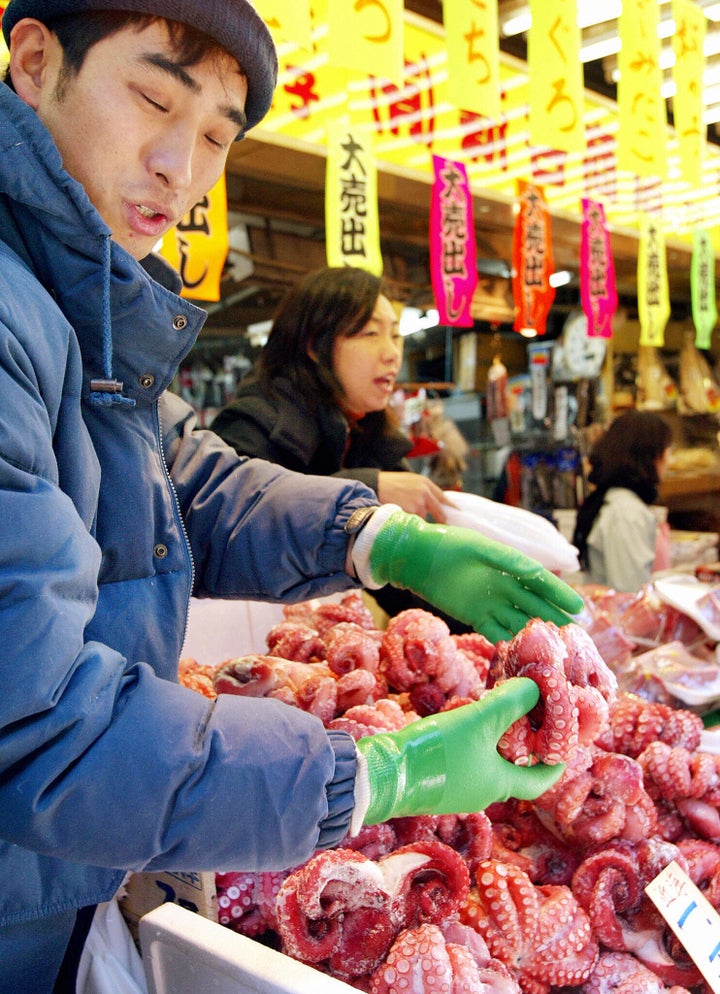
A couple months ago, I wrote about my eye-opening Christmas dinner conversation that left my world rocked by the realization that soy bean paste (known in Korean as dwen jang) and soy sauce come from the same process.
I had asked my dad, "Who the heck thinks, 'hey this fermented brown stuff that looks suspiciously like poop, and kind of smells like it... I'm gonna eat this.'"
"People like you, Michelle," my dad replied.
So, inspired by my father's faith in my adventurous palate, I decided to embark upon a journey into the depths of the sea. Not really, but kind of.
I wanted to try live octopus. Not as in, grab one out of the water and chomp into it (which frankly, sounds cooler), but the prepared kind that is native to Korean culture. My friend who is conveniently a film maker, Evan Leong, came with me. We also convinced his parents to join. It was a party of 3 people who adamantly said they would not be tongue-tangoing with the tentacles... and me. I am down to tango anyday.
We visited Sik Gaek in Flushing, Queens, because, let's face it, Flushing is the place to get authentic Korean food. The atmosphere was awesome. There are a bunch of chill stools and long tables in the center of the restaurant. There are booths around the periphery if you want something a little more formal and private. But, obviously, we wanted to have the down and dirty experience.
I would say that I have tried almost every kind of odd Korean food: silkworm larvae (bun dae gi), stuffed intesines (soondae), these powdery block candy-like things made of pine needles or something that taste like dirt (I have no idea what they are called but my mom made me try one in a Korean department store once). But I've never had the chance to eat live octopus. It's a pretty amazing vision. They take the octopus (which they fly in from Korea a couple times a week), and remove the head and guts. The tentacles are then chopped up into bite-sized pieces -- and they move! They continue to move for at least 15 minutes. Getting those suckers off the plate was something else. By suckers, I mean literally the suckers on the tentacles, because they continue to suction. So, here is another tip: When you put it in your mouth and it suctions onto your gums or cheeks (and it will), slide your tongue under it to facilitate chewing.
Also, my mother freaked me out a bit by saying they could suction onto your throat and then you might die. But after this experience, I realized that's just something moms say. For example, "Don't forget to wear your scarf, you may catch something terrible and it will get worse and then you might die." Or, "Don't drink alcohol, because then you may not realize you are so drunk and you will get alcohol poisoning and fall into a sewer so you can't be rushed to the hospital and then you might die."
Realizing that there was extremely minimal risk of death, I decided that it was lonely eating the tentacles by myself and thus recruited 3 happy white folks (who you can enjoy watching in the video). They impressed me with their presence at such a authentically Korean restaurant. Even cooler, they agreed to try the moving octopus legs. And, while there were a couple "ews" and shrieks, in the end the consensus was -- hey, that's not so bad!
After having eaten half the plateful, I realized I was there to learn history, not just chow down and force other people to eat the moving food in my own personal version of Fear Factor. I asked the floor manager what it was that made Korean people think, "Okay, let's eat this live this time." Was it the Korean quest for adventure? Was it too much soju? Was it a bunch of 15th century Korean frat boys with popped oriental collars who were egging each other on?
The floor manager explained historically, Koreans believed this food would increase strength and stamina. This was not the most satisfying response, but I will take it.
Two hours later, there were only 3 straggler tentacle pieces left. What began as a little bit of initial hesitation, had turned to full-on live octopus eating expertise. I am pretty confident that I can walk anyone through this process. In fact, if you would like me to join you on your Korean deep-sea odyssey, I'm happy to discuss a dayrate to be your guide.
Next month, I plan to badger my parents into showing me the secret Korean tactics for making the best kimchi in the world. Then I will share with all of you.
For now, watch the awesome video that Evan Leong of Arowana Films made to document the experience.